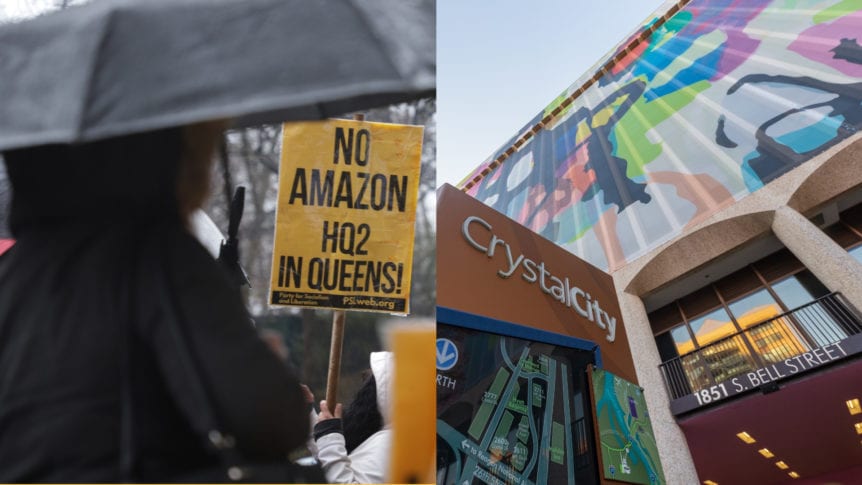
Amazon HQ2 Down to One Locale. Now What?
Ending a year-long pageant of North America’s best real estate, Amazon announced a final decision in late November 2018 to divide its second headquarters between Arlington, Virginia’s Crystal City neighborhood and Long Island City in Queens. The project was dubbed Amazon HQ2.
The decision was made, to the east coast went the spoils and the remaining finalists were left to plan for tomorrow. Then things changed.
Three months after its announcement, Amazon rescinded its New York plans.
Citing pushback from community groups, the online retailer said they have no intention to pursue further HQ2 plans in New York. Though plans would proceed with the Crystal City location, along with a smaller “Operations Center of Excellence” in Nashville, speculation about Amazon revisiting opportunities in other metros abounds.
Originally pitched as a single, 50,000-employee corporate site, the final HQ2 plan ultimately divided the investment between two cities for a variety of reasons: a larger talent pool, fears of overburdened transit, and dodging an affordable housing crisis have all been given as reasons for Amazon’s stance.
Known for its sharp eye for a good deal, Amazon was flooded with business incentive offers during the initial bid process. States like Pennsylvania and Ohio offered $4.6 billion and $2.8 billion respectively, while bids from other locales like New Jersey and Maryland came in at $7 billion and $5 billion.
The Long Island City headquarters stood to receive $2.988 billion in state and city funds. Additionally, the campus was plotted in an opportunity zone, a federal tax incentive program which allows investors to incrementally defer or avoid capital gains taxes for placing a financial stake in economically struggling communities.
(A fair share of criticism surrounds the opportunity zone program with detractors accusing its inclusion of well-to-do areas, while ignoring more poverty-stricken neighborhoods, as having the potential for investor misuse.)
The added spotlight and publicity for these finalist cities could result in additional development for their pitched sites, even if Amazon remains true to their promise of no additional HQ2 development.
Indeed, business leaders and officials from bid finalist cities like Dallas and Chicago have issued their own statements assuring a willingness to work with Amazon, should the company reconsider reviving plans.
The Related Companies mixed use site, The 78, in Chicago warranted a second look from Amazon as it made its rounds in August. While ultimately not selected, the development intends to move forward. Share on X
The surrounding neighborhoods include 39 multifamily projects with an estimated 6,299 units planned or scheduled to break ground in the next 12 months according to BuildCentral’s data.
With only 123 of those units across two developments falling in opportunity zones, a great deal of room remains for subsidized projects.
We’ve listed the top 5 multifamily projects here:
Newark, N.J., another finalist putting up big incentives, selected six sites for its bid.
Each one of those fell square within three abutting opportunity zones, with BuildCentral currently tracking 19 multifamily projects within those boundaries, either in planning or preparing to start construction within the year.
5 of those projects are mapped here:
As for Long Island City, as of late January 2019, BuildCentral reports 49 multifamily projects in the surrounding Long Island City area currently in the planning stage, with 19 of those located within opportunity zones and accounting for an estimated 2,155 proposed units. 5 of the top projects are mapped here:
Leading these proposals is TF Cornerstone’s 52-03 Center Boulevard Mixed-Use project, an 800-unit skyscraper less than a 15 minute walk from the late Long Island Innovation Center project.
TF Cornerstone was to collaborate with New York City on the mixed-use incubator, building a 1,000-unit multifamily component with 250 units set aside as affordable. Those plans were halted though when the developer decided to pursue commercial space for HQ2 on its portion of the site.
The decision to abandon multifamily at the site, along with Plaxall’s reassessment of residential construction in the Anable Basin, could result in the loss of 1,500 planned affordable units from the area directly from HQ2, potentially to be relocated within neighboring opportunity zones.
And while Crystal City’s HQ2 doesn’t directly sit in an opportunity zone, the region is much larger than Long Island City, with The Stephen S. Fuller Institute at George Mason University projecting only 16.4% of HQ2 employees will live in Arlington, while 63.5% live in the immediate, surrounding Virginia, D.C. and Maryland counties.
The largest of these areas is anticipated to be Fairfax County, with 33% of employees anticipated to call it home. BuildCentral is currently reporting 64 multifamily projects planned or to break ground within the year.
Here are 5 of those projects:
Crystal City directly borders two opportunity zones, with the affected metro area host to many others. Nine zones currently call Arlington and the surrounding counties home, while four and 19 zones respectively sit in nearby Maryland… Share on X
A Congressional Research Service report found these surrounding zones might see their own development boom from investors seeking “higher returns on investments for housing, retail, and commercial projects” marketed to Amazon employees.
Summary
While some New York investors are likely already feeling the sting of Amazon HQ2 forgoing the Long Island City location, it remains to be seen whether northern Virginia-area investors and new homeowners alike will be rewarded – or regretful as Amazon’s plans for Crystal City come into sharper focus.
For more insights that give you a leg up on the competition and help you find new customers faster, sign up for a free trial at Multifamilydata.com

